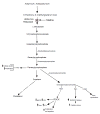Pleiotropic Effects of Statins on the Cardiovascular System
- PMID: 28057795
- PMCID: PMC5467317
- DOI: 10.1161/CIRCRESAHA.116.308537
Pleiotropic Effects of Statins on the Cardiovascular System
Erratum in
-
Correction to: Pleiotropic Effects of Statins on the Cardiovascular System.Circ Res. 2018 Sep 28;123(8):e20. doi: 10.1161/RES.0000000000000228. Circ Res. 2018. PMID: 30355038 No abstract available.
Abstract
The statins have been used for 30 years to prevent coronary artery disease and stroke. Their primary mechanism of action is the lowering of serum cholesterol through inhibiting hepatic cholesterol biosynthesis thereby upregulating the hepatic low-density lipoprotein (LDL) receptors and increasing the clearance of LDL-cholesterol. Statins may exert cardiovascular protective effects that are independent of LDL-cholesterol lowering called pleiotropic effects. Because statins inhibit the production of isoprenoid intermediates in the cholesterol biosynthetic pathway, the post-translational prenylation of small GTP-binding proteins such as Rho and Rac, and their downstream effectors such as Rho kinase and nicotinamide adenine dinucleotide phosphate oxidases are also inhibited. In cell culture and animal studies, these effects alter the expression of endothelial nitric oxide synthase, the stability of atherosclerotic plaques, the production of proinflammatory cytokines and reactive oxygen species, the reactivity of platelets, and the development of cardiac hypertrophy and fibrosis. The relative contributions of statin pleiotropy to clinical outcomes, however, remain a matter of debate and are hard to quantify because the degree of isoprenoid inhibition by statins correlates to some extent with the amount of LDL-cholesterol reduction. This review examines some of the currently proposed molecular mechanisms for statin pleiotropy and discusses whether they could have any clinical relevance in cardiovascular disease.
Keywords: cardiovascular diseases; cholesterol, LDL; hydroxymethylglutaryl-CoA reductase inhibitors; rho-associated kinases; vascular diseases.
© 2017 American Heart Association, Inc.
Conflict of interest statement
There are no conflicts of interests for all of the authors
Figures




References
-
- Mendis S, Davis S, Norrving B. Organizational update: the world health organization global status report on noncommunicable diseases 2014; one more landmark step in the combat against stroke and vascular disease. Stroke. 2015;46:e121–122. - PubMed
-
- Ference BA, Majeed F, Penumetcha R, Flack JM, Brook RD. Effect of naturally random allocation to lower low-density lipoprotein cholesterol on the risk of coronary heart disease mediated by polymorphisms in NPC1L1, HMGCR, or both: a 2 × 2 factorial Mendelian randomization study. J Am Coll Cardiol. 2015;65:1552–1561. - PMC - PubMed
-
- Istvan ES, Deisenhofer J. Structural mechanism for statin inhibition of HMG-CoA reductase. Science. 2001;292:1160–1164. - PubMed
-
- Scandinavian Simvastatin Survival Study G. Randomised trial of cholesterol lowering in 4444 patients with coronary heart disease: the Scandinavian Simvastatin Survival Study (4S) Lancet. 1994;344:1383–1389. - PubMed
Publication types
MeSH terms
Substances
Grants and funding
LinkOut - more resources
Full Text Sources
Other Literature Sources
Medical
Miscellaneous

